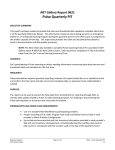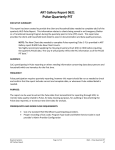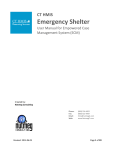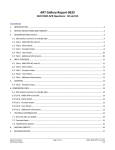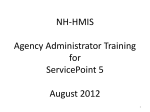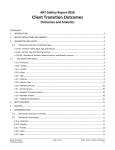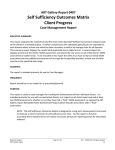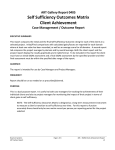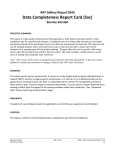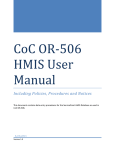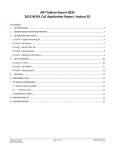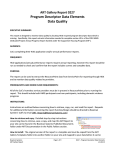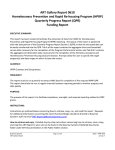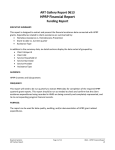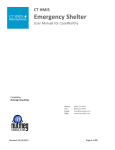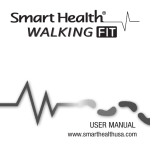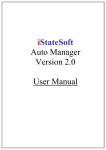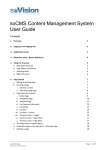Download User Manual
Transcript
ART Gallery Report 0630 Sheltered PIT Count EXECUTIVE SUMMARY: This report has been created to provide the client and household data needed to complete the sheltered portion of the “Homeless Populations” tab and the “Homeless Subpopulation” tab in the 2012 Annual Point‐In‐Time module of the HUD HDX. This information relates to clients being served in an Emergency Shelter, Transitional Housing, or Safe Haven Program at the time or the annual homeless count. Clients are identified based on their program enrollment (EE) status; their shelter specific service transactions and their ShelterPoint shelter stays. This report also provides the client and household level detail to assist in documentation and data quality processes. AUDIENCE: CoCs which are participating in the HUD PIT count or others needing information concerning data about persons and household which are homeless at a specific point in time. FREQUENCY: Homeless Point‐In‐Time counts are conducted as required by HUD or as determined by the CoC – usually annually, however this report can be also be run between counts to monitor the size and demographics of the sheltered homeless population. PURPOSE: The report can be used to extract data from ServicePoint for reporting through the HDX, to monitor data quality related to the PIT count, for data cleaning purposes, for auditing or documenting the PIT count data reported, or to extract homeless client data for analysis. PREREQUISITES AND WORK FLOW REQUIREMENTS ServicePoint version 5.0 of higher ART version 3.0 or higher Use of a standard HUD Workflow by participating providers. Proper recording of Program CoC Code, Program Type Code and Shelter Service Code in the Admin Provider Configurations for each provider in the dataset Bowman Systems ART Gallery Report Page 1 of 18 0630 – Sheltered PIT Count v3 INSTRUCTIONS: The easiest way to start using this report is to navigate to the automapper. This is a folder that has the reports automatically mapped to your site, so that you don’t have to map them yourself. You can navigate to the automapper as shown in Diagram 1, below: Diagram 1 Requests for additional information concerning the report function/design should be directed to Bowman Systems’ Customer Support Specialist (CSS) staff. Before running the report: Prior to running the report the user must have access to: A complete list of the CoC’s participating Emergency Shelter, Transitional Housing, and Safe Haven providers. Exact date of the PIT Count The Proper CoC code for the data set How to run: Upon opening the report, the user will be prompted (see Diagram 2) to specify parameters which control the data returned by the report. Once the user has provided these parameters by responding to the user prompts, a green check‐mark will appear next to each field to indicate that a selection has been made. The user should then single‐click the “Run Query” button to generate the report. Bowman Systems ART Gallery Report Page 2 of 18 0630 – Sheltered PIT Count v3 Diagram 2 Bowman Systems ART Gallery Report Page 3 of 18 0630 – Sheltered PIT Count v3 There are three user prompts connected with this report: 1. Enter effective date The user should type in, or select from the calendar, the day immediately following the day of the PIT count. For example, if the reporting quarterly PIT is October 24, 2009, then October 25, 2009 should be entered/selected. 2. Enter the Pit Date PLUS 1 Day: The user should type in, or select from the calendar, the day immediately following the day of the PIT count. For example, if the PIT was conducted on October 24, 2009, then October 25, 2009 should be entered/selected. 3. Select Provider(s): Click the “refresh list” icon and wait for the left window to refresh. Now select the provider or providers to include, by highlighting them in the left window and moving them into the right window using the right selection arrow. Important NOTE: All selected providers must be an Emergency Shelter Program, Transitional Housing Program, or Safe Haven Program as indicated by their Program Type Code. Selected Providers with a missing or different Program Type Code will NOT be included in the report results. All selected providers must also have the specified CoC Code. Selected Providers with a missing or conflicting CoC Code will NOT be included in the report results. How to read: This report contains six data tabs. Each tab is a sub‐report containing three sections: Report Header: The header contains the title of the report and the tab/subreport. When running the report in “modify” view, the report header is only visible in print/page layout mode. Report Footer: The report footer contains the title of the report, the name of the tab/sub‐ report, the page number, the version number, and the date/time the report was run /printed. Like the header, the footer is only visible in print mode when the report is run in modify view. Report Body: The report body is the main section of the report located between the header and the footer where the reports data is displayed in a variety of different chart formats. The data contained in each of the tabs in this report is displayed and described below: Bowman Systems ART Gallery Report Page 4 of 18 0630 – Sheltered PIT Count v3 Diagram 3 Tab A – Homeless Populations (Diagram 3): This tab contains unduplicated PIT counts of clients and household. Data is broken down by program type is also included and household type according the HUD PIT guidelines. Data is laid out to mirror the HDX data input screen. To be included in the count, providers must be an Emergency Shelter Program, Transitional Housing Program, or a Safe Haven as indicated by their Program Type Code and must also have the specified CoC Code. If a provider has been selected that does NOT meet these conditions, the provider will be shown in the Tab F “Value Selected” section, but will be absent from the Tab F “Providers Reporting Information…” listing. Cells that automatically calculated on the HDX input screen are shown on a gray background, while data required to be transferred to the HDX is shown on a white background. Bowman Systems ART Gallery Report Page 5 of 18 0630 – Sheltered PIT Count v3 Diagram 4 Tab B – Homeless Subpopulations (Diagram 4): This tab contains unduplicated Sheltered PIT counts of clients broken down by the various HUD subpopulation categories required to be reported. In the case of chronically homeless individuals a breakdown by program type is also included. Per HUD directive, only adults over the age of 17 are included for the Domestic Violence, HIV/AIDS, Substance Abuse, Mental Illness, and Chronically Homeless Individual categories. The Unaccompanied Youth category contains only individuals under the age of 18, and the Chronically Homeless Family (Persons) contains both adults (18 +) and children (<18). To be included in the count, providers must have an appropriate Program Type Code and the specified CoC Code. If a provider has been selected that does NOT meet these conditions, the provider will be shown in the Tab F “Value Selected” section, but will be absent from the Tab F “Providers Reporting Information…” listing. Again, cells that automatically calculating cells are shown on a gray background, while those requiring transfer are shown on a white background. Bowman Systems ART Gallery Report Page 6 of 18 0630 – Sheltered PIT Count v3 Diagram 5 Tab C – Client Detail (Diagram 5): Data on this client detail tab is not transferred to the HDX but rather is provided for reference and data cleaning purposes. This tab displays all clients sorted by Client Uid which are included in the Tab A and Tab B counts along with their pertinent information as recorded in ServicePoint. A red “null” notation indicates missing data. When “na” appears in the End column, it indicates that the client was still actively enrolled at the end of the reporting period. The last two columns indicate whether the client’s inclusion in the PIT count is based on an Entry Exit (E), a Shelter Service Transaction (Svc), or a ShelterPoint Shelter Stay (SH) and the type of program involved; Emergency Shelter (ES), Transitional Housing (TH), or Safe Haven (SH) Bowman Systems ART Gallery Report Page 7 of 18 0630 – Sheltered PIT Count v3 Diagram 6 Tab D – Household Detail (Diagram 6): Like Tab C, this tab contains PIT count detail, but is sorted by household rather than by client. The listing is sectioned by household type, with the first column indicating the household grouping as indexed by the Entry Exit or Service Group Id (see tech note # 4). As in Tab C, a red “null” notation indicates missing data and when “na” appears in the End column, it indicates that the client was still actively enrolled at the end of the reporting period. Again, the last two columns indicate whether the client’s inclusion in the PIT count is based on an Entry Exit (E), a Shelter Service Transaction (Svc), or a ShelterPoint Shelter Stay (SH) and the type of program involved; Emergency Shelter (ES), Transitional Housing (TH), or Safe Haven (SH). Bowman Systems ART Gallery Report Page 8 of 18 0630 – Sheltered PIT Count v3 Diagram 7 Tab E – Subpopulations (Diagram 7): This tab contains a section for each of the seven subpopulations in Tab B. Each section displays the list of clients included it the count of that particular subpopulation. Each list/section includes various pertinent fields and is sorted by Client Uid. Should the client be missing any required data, such null values will be displayed “null” in red font. Bowman Systems ART Gallery Report Page 9 of 18 0630 – Sheltered PIT Count v3 Diagram 8 Tab G – Additional Information (Diagram 8): This tab is provided as a reference to the user running the report and lists the parameters specified in the user prompts, as well as client counts by provider. Bowman Systems ART Gallery Report Page 10 of 18 0630 – Sheltered PIT Count v3 TECHNICAL NOTES 1) De‐duplication: This report de‐duplicates client counts using ServicePoint’s Client Unique Id field. Household counts are de‐duplicated using the HH Group number described in tech note 4 below. 2) Inclusion: In order for a client/household to be included in the PIT count in this report, the client must have been serve on count day as evidenced by one or more of the following: a) An Emergency Shelter, Transitional Housing, or Safe Haven type service transaction by a specified provider with a start date on or before count day and an end date that was after count day or null. b) Enrollment in a specified Emergency Shelter, Transitional Housing, or Safe Haven type program with an entry date on or before count day and an exit date that was after count day or null. c) A ShelterPoint shelter stay by a specified Emergency Shelter or Transitional Housing type program beginning on or before count day and ending after count day (or not ending). 3) Household Type Determination: a) Only a client’s entry/service connected with their PIT count is considered in the determination of household type. (Previous or subsequent entries/services within the quarter are not considered even though they may include a different household makeup.) b) In the event a multi person household is served in separate groups, households are calculated based on group id content. For example consider this single mother with 3 children: Mother receives shelter on count day and is counted as a single. Later in the quarter the mother is joined in the shelter by her children. The mother is still considered a single in the count since her children were not with her at that point in time. c) Household type is determined by the number and ages of clients entering or being served as a household group on count day. (Clients sharing a single entry exit group id or a single service group id). Households in this report are divided into the three distinct types as defined in the HUD literature. These types include: 1. Households which include both adults and children (aka HUD Family). In this type of household, at least one person in the household must be under the age of 18 on count day, and at least one person in the household must be above the age of 17 on count day. 2. Households which include children only. This may be an unaccompanied individual under the age of 18 on count day, or multiple household members all of whom must be under the age of 18 on count day. 3. Households which include adults only. This may be an unaccompanied individual over the age of 17 on count day, or multiple household members all of whom must be over the age of 17 on the day of the count. Bowman Systems ART Gallery Report Page 11 of 18 0630 – Sheltered PIT Count v3 d) In the event that the household type cannot be determined because the age of a household member is unknown (null date of birth value), then the type of household is determined by a set of null‐handling instructions provided by HUD to the software vendors producing the report (see Diagram 9 below): Diagram 9 4) Household Groupings: The household grouping number displayed in Tabs C, D and E is used for counting households throughout this report. The “HH Group” is an auto generated index number constructed using the Entry Exit Group Id, Service Group Id, Entry Exit Id, or Service Id as described below: a) If the client’s count day housing event is a service or a ShelterPoint shelter stay, and the Service Group Id is not null (indicating a shared service) then the Service Group Id number is used as the index number. b) If the client’s count day housing event is a program entry into an Emergency Shelter or Transitional Housing program, and the Entry Exit Group Id is not null (indicating a shared entry) then the Entry Exit Group Id number is used as the index number. c) If the client’s count day housing event is a program entry, and the Entry Exit Group Id connected with that entry is null (indicating a unshared entry) then the Entry Exit Id number is used as the index number. d) If the client’s count day housing event is a housing service or shelter stay and the Service Group Id connected with that entry is null (indicating a unshared entry) then the Service Id number is used as the index number. 5) Query Design: It should be noted that this report uses union type combine queries, in which service and shelter stay events from “query 2” are combined with and folded into the entry exit events from “query 1”, however the results objects from this combine query retain the field labels from Bowman Systems ART Gallery Report Page 12 of 18 0630 – Sheltered PIT Count v3 query 1. For example the results object labeled “entry exit entry date” contains both entry dates and service start dates. 6) Hidden columns: It should be noted that the tables in Tabs C and D each include two hidden columns. These hidden columns contain data which is necessary to the proper functioning of the report and should not be removed. The hidden columns are located on the far right‐hand side of the tables and can be accessed in “structure” view. 7) Screen Shots: It should be noted that screen shots provided in this user manual have been selected from multiple instances of the report to display certain features, or to fit a single page, and do not necessarily correspond to one another. Numbers and totals from one screen shot therefore should not be expected to relate to numbers or totals in another screen shot, since different parameters may have been used in producing the screen shots. 8) Chronically Homeless Individuals: To be counted as a Chronically Homeless Individual in this report the person must meet 4 criteria: a) A “Yes” answer to the “Is client chronically homeless?” question at the time of the PIT count. b) A recorded DOB indicating that the client was age 18 or older at the time of the PIT count. (Clients with a missing DOB are also considered to be adults for the purpose of chronic homelessness determination) c) A “Yes (HUD)” answer to the “Does the Client Have a disability of long term duration?” question at the time of the PIT count. d) The client must be unaccompanied with regards to their PIT related program enrollment/ shelter stay/shelter service. 9) Chronically Homeless Households: To be counted as a Chronically Homeless Household in this report the household must contain one or more persons meeting four criteria: a) A “Yes” answer to the “Is client chronically homeless?” question at the time of the PIT count. b) A recorded DOB indicating that the client was age 18 or older at the time of the PIT count. (Clients with a missing DOB are also considered to be adults for the purpose of chronic homelessness determination) c) A “Yes (HUD)” answer to the “Does the Client Have a disability of long term duration?” question at the time of the PIT count. d) The client must share the PIT related program enrollment/ shelter stay/shelter service, with one or more other individuals. (Theses other household members are not subject to these criteria) Note: Although the new HUD guidance still requires that a client be single/unaccompanied in order to be considered a chronically homeless individual, chronically homeless household members are now also recognized and counted. Implementations that have recently used the single/unaccompanied criteria in determining the answer to the “Chronically Homeless?” yes/no question, may be undercounting chronically homeless households, and may wish to review their Bowman Systems ART Gallery Report Page 13 of 18 0630 – Sheltered PIT Count v3 chronically homeless determinations to see that they are consistent with these new guidelines. 10) CH Count Type: In Tab D the first section includes a listing of all client who have a “Yes” answer to the “Chronically Homeless ?” question. The column entitled “CH Count Type” indicates how each of these clients is involved (or not involved) in the counts. The clients fall into four categories: CH Individual: These clients meet all the criteria described in tech note # 8 and are therefore included in the count as Chronically Homeless Individuals. Family Member CH: These clients meet all the criteria described in tech note # 9 and are therefore included in the count of persons in a Chronically Homeless Family Family Member Other: These clients meet do not meet all the criteria described in tech note #9 but share a program entry/shelter service/shelter stay with someone who does, and are therefore included in the count of persons in a Chronically Homeless Family Not counted: These clients have a yes answer to the a “yes” answer to the “Chronically Homeless ?” question, but do not meet one or more of the other criteria described in tech note 8/9 and are therefore not counted in any of the chronically homeless categories. REPORT MODIFICATION Because this report is based on HUD established reporting instructions, modification is generally not recommended, especially with regards to the queries, variables, and formulas that impact the HDX data. Bowman Systems ART Gallery Report Page 14 of 18 0630 – Sheltered PIT Count v3 MAPPING OBJECTS UNIVERSE: template_u template_provider_u This report is mapped to the client universe (template_u) and provider universe (template_provider_u) and should be copied to your Public or Favorite folder then mapped to the equivalent event universes for your site (ex. yoursite_u). Mapping for the client universe can be done from the first query PIT. Mapping for the provider universe can be done from the second query Beds. QUERY NAME FIELD NAME Client Uid Client Unique Id Age (Calculated) Gender(894) Entry Exit Uid PIT Entry Exit Entry Date Entry Exit Exit Date Entry Exit Group Id Entry Exit Provider Id Entry Exit Provider COC Code Entry Exit Provider Program Type Code Client Inactive Bowman Systems ART Gallery Report LOCATION/TYPE/USE Location: Clients Type: System Field Use: Result Object Location: Clients Type: System Field Use: Result Object Location: Clients / Assessments / Additional Profile Information(21) Type: Assessment Question Use: Result Object Location: Clients / Assessments / Additional Profile Information(21) Type: Assessment Question Use: Result Object Location: Clients / Entry Exit (Outer) Type: System Field Use: Result Object Location: Clients / Entry Exit (Outer) Type: System Field Use: Result Object Location: Clients / Entry Exit (Outer) Type: System Field Use: Result Object Location: Clients / Entry Exit (Outer) Type: System Field Use: Result Object Location: Clients / Entry Exit (Outer) Type: System Field Use: Result Object Location: Clients / Entry Exit (Outer) / Entry Exit Provider Id Type: System Field Use: Result Object Location: Clients / Entry Exit (Outer) / Entry Exit Provider Id Type: System Field Use: Result Object Location: Clients Type: System Field Use: Query Filter Page 15 of 18 0630 – Sheltered PIT Count v3 Entry Exit Inactive Service Uid Service Provide Start Date Service Provide End Date Service Group Id PIT Service Provide Provider Service Provide Provider COC Code Service Provide Provider Program Type Code Service Inactive Service Shelter Item Service Code Description Location: Type: Use: Location: Type: Use: Location: Type: Use: Location: Type: Use: Location: Type: Use: Location: Type: Use: Location: Type: Use: Location: Type: Use: Location: Type: Use: Location: Type: Use: Location: Type: Use: Clients / Entry Exit (Outer) / Entry Exit Provider Id System Field Query Filter Clients / Services (Outer) System Field Result Object Clients / Services (Outer) System Field Result Object Clients / Services (Outer) System Field Result Object Clients / Services (Outer) System Field Result Object Clients / Services (Outer) System Field Result Object Clients / Services (Outer) / Service Provide Provider System Field Result Object Clients / Services (Outer) / Service Provide Provider System Field Result Object Clients / Services (Outer) System Field Query Filter Clients / Services (Outer) System Field Query Filter Clients / Services (Outer) System Field Query Filter Bowman Systems ART Gallery Report Page 16 of 18 0630 – Sheltered PIT Count v3 QUERY NAME FIELD NAME LOCATION/TYPE/USE Providers Provider Merge Id Providers COC Code Bedlist Inventory Uid Bedlist Inventory Name Bedlist Inventory HMIS Participating Beds Bedlist Inventory HMIS Participating Start Date Bedlist Inventory HMIS Participating End Date Bedlist Inventory Bed Type Beds Bedlist Inventory Availability Bedlist Inventory Bed Inventory Providers Program Type Code Bedlist Inventory Household Type Bedlist Inventory Target Population B Bedlist Inventory Start Date Bedlist Inventory End Date Providers Inactive Bedlist Inventory Inactive Bowman Systems ART Gallery Report Location: Type: Use: Location: Type: Use: Location: Type: Use: Location: Type: Use: Location: Type: Use: Location: Type: Use: Location: Type: Use: Location: Type: Use: Location: Type: Use: Location: Type: Use: Location: Type: Use: Location: Type: Use: Location: Type: Use: Location: Type: Use: Location: Type: Use: Location: Type: Use: Location: Type: Use: Providers System Field Result Object Providers System Field Result Object Bedlist Inventory System Field Result Object Bedlist Inventory System Field Result Object Bedlist Inventory System Field Result Object Bedlist Inventory System Field Result Object Bedlist Inventory System Field Result Object Bedlist Inventory System Field Result Object Bedlist Inventory System Field Result Object Bedlist Inventory System Field Result Object Providers System Field Result Object Bedlist Inventory System Field Result Object Bedlist Inventory System Field Result Object Bedlist Inventory System Field Result Object Bedlist Inventory System Field Result Object Providers System Field Query Filters Bedlist Inventory System Field Query Filters Page 17 of 18 0630 – Sheltered PIT Count v3 QUERY NAME FIELD NAME Providers Provider Merge Id Providers COC Code Providers Providers Program Type Code Providers Inactive Providers Date Added LOCATION/TYPE/USE Location: Type: Use: Location: Type: Use: Location: Type: Use: Location: Type: Use: Location: Type: Use: Providers System Field Result Object Providers System Field Result Object Providers System Field Result Object Providers System Field Query Filters Providers System Field Query Filters #0630 Revision History Version V11.04.13 V11.06.28 V3 Description of Changes Original version –BETA Revision BETA: corrects a customer reported product defect related to counting of substance abuse clients on Tab B adds an input control filter to Tab B for sorting filtering by program type Revision: Update instructions to show automapper. Correct error that eliminated disabilities that occurred before but on the same day of the transaction. Include “Homeless Shelter” service code in PIT and Disab queries. Remove “Safe Haven” cells from the “Persons in Households with Only Children” section. Bowman Systems ART Gallery Report Page 18 of 18 0630 – Sheltered PIT Count v3


















